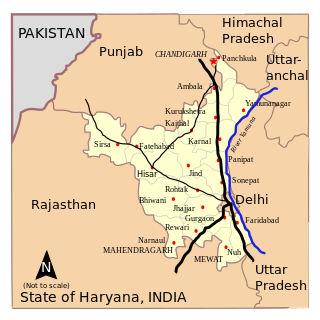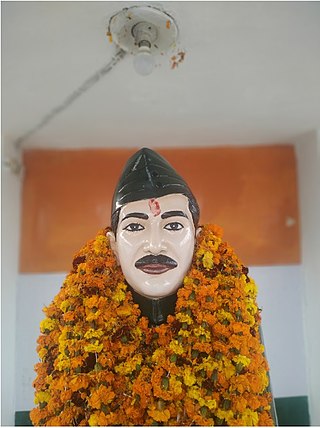
Singh is a title, middle name, or surname that means "lion" in various South Asian and Southeast Asian communities. Traditionally used by the Hindu Kshatriya community, it was later mandated in the late 17th century by Guru Gobind Singh for all male Sikhs as well, in part as a rejection of caste-based prejudice and to emulate Rajput naming conventions. As a surname or a middle name, it is now found throughout the world across communities and religious groups, becoming more of a generic, caste-neutral, decorative name.

Dalit, also some of them previously known as untouchables, is the lowest stratum of the castes in the Indian subcontinent. Dalits were excluded from the fourfold varna of the caste hierarchy and were seen as forming a fifth varna, also known by the name of Panchama. Several scholars have drawn parallels between Dalits and the Burakumin of Japan, the Baekjeong of Korea and the peasant class of the medieval European feudal system.
In Hindu culture, the term gotra is considered to be equivalent to lineage. It broadly refers to people who are descendants in an unbroken male line from a common male ancestor or patriline. Generally, the gotra forms an exogamous unit, with marriage within the same gotra being regarded as incest and prohibited by custom. The name of the gotra can be used as a surname, but it is different from a surname and is strictly maintained because of its importance in marriages among Hindus, especially among castes. Pāṇini defines gotra as apatyam pautraprabhrti gotram, which means "the word gotra denotes the descendance, apatya, of a couple consisting of a pautra, a son and a bharti, a mother, i.e. a daughter-in-law."
The Other Backward Class (OBC) is a collective term used by the Government of India to classify castes that are educationally or socially backward. It is one of several official classifications of the population of India, along with general castes, Scheduled Castes and Scheduled Tribes (SCs and STs). The OBCs were found to comprise 52% of the country's population by the Mandal Commission report of 1980 and were determined to be 41% in 2006 when the National Sample Survey Organisation took place. There is substantial debate over the exact number of OBCs in India; it is generally estimated to be sizable, but many believe that it is higher than the figures quoted by either the Mandal Commission or the National Sample Survey.
Gram Panchayat is a basic governing institution in Indian villages. It is a political institution, acting as the cabinet of a village or group of villages. The Gram Sabha works as the general body of the Gram Panchayat. The members of the gram panchayat are elected directly by the people. The gram panchayat is headed by an elected President and Vice President, assisted by a Secretary who serves as the administrative head of the panchayat. The president of a gram panchayat is known as a "Pradhan" or "Sarpanch" in Northern India. There are about 250,000 gram panchayats present in India.
Dabas is an exogamous, patrilineal Jat gotra (clan) of India. Among their locales are the Haryana state and Delhi.
A sarpanch, gram pradhan, mukhiya, or president is a decision-maker, elected by the village-level constitutional body of local self-government called the gram sabha in India. The sarpanch, together with other elected panchayat members, constitute gram panchayats and zilla panchayats. The sarpanch is the focal point of contact between government officers and the village community and retains power for five years. the term used to refer to the sarpanch can vary across different states of India. Here are some of the commonly used terms for sarpanch in various states: panchayat president, gram pramukh, gram pradhan, gram adhyaksha, gaon panchayat president, gram panchayat president, etc.
Gohana is a city and a municipal council, near Sonipat city in the Sonipat district of the Indian state of Haryana.
A Khap is a community organisation representing a clan or a group of North Indian castes or clans. They are found mostly in northern India, particularly among the Village people of Haryana and Western Uttar Pradesh (Jats), but also amongst states like Rajasthan and Madhya Pradesh although historically the term has also been used among other communities. A Khap Panchayat is an assembly of Khap elders, and a Sarv Khap is an assembly of many Khap Panchayats.
Ror is a caste found primarily in the Indian state of Haryana.

In India, a caste, although a western stratification arrived from Portuguese word Casta and Latin word castus, is a social group where membership is decided by birth. Broadly, Indian castes are legally divided into Forward Castes, Other Backward Classes, Scheduled Castes, and Scheduled Tribes. Indian Christians and Indian Muslims are also function as castes. With castes separating individuals into different social groups, it follows that each group will have conflicting interests; oftentimes putting those with lower social standing in less favorable positions. The Constitutuent Assembly which was head by B.R. Ambedkar, the founder of the Depressed Classes Association which had originally put forward these demands, created the reservation system, which essentially acts as affirmative action to provide representation to caste groups that have been systematically disadvantaged. However other castes which have not been provided reservations, have called this system unfair and politically motivated. There have also been other cases where political parties, like the Bahujan Samaj Party (BSP), was formed to represent the minority or lower communities.
Caste-related violence in India has occurred and continues to occur in various forms.
The Manoj–Babli honour killing case was the honour killing of Indian newlyweds Manoj Banwala and Babli in June 2007 and the subsequent court case which historically convicted defendants for an honour killing. The accused in the murder included relatives of Babli. Relatives of Manoj, especially his mother, defended the relationship.

Elections in Haryana, which is a state in India, have been conducted since 1967 to elect the members of state-level Haryana Legislative Assembly and national-level Lok Sabha. There are 90 assembly constituencies and 10 Lok Sabha constituencies.
Raj Kumar Saini is an Indian politician. He was the MP of Kurukshetra, Haryana. In 2014 he became a member of 16th Lok Sabha by defeating 2 times MP from Indian National Congress Naveen Jindal.

The Jat reservation agitation was a series of violent protests in February 2016 by the Jat people of North India, especially those in the state of Haryana, which "paralysed" the state for 10 days. The protestors sought inclusion of their caste in the Other Backward Class (OBC) category, which would make them eligible for affirmative action benefits. Besides Haryana, the protests also spread to the neighbouring states, such as Uttar Pradesh, Rajasthan, and the National Capital Region.
Khanda is a big & historical village in Kharkhoda tehsil of Sonipat district in Haryana, India. It is located 2 miles (3.2 km) from Kharkhoda and 7 miles (11 km) from Sonipat. It is a part of the Delhi NCR. Khanda has two Gram Panchayats Khanda Khas & Khanda Alman. Two Sarpanchs elects from the village in every five years. Khanda is the head of 12 villages of Dahiya Khap mainly known as.
Kalali is a village and administrative unit with a democratically elected panchayat samiti in the Loharu, Siwani Tehsil of Bhiwani District under Bhiwani-Mahendragarh Lok Sabha constituency and Hisar Division of Haryana state.

Dahiya Khap is a Khap of the Dahiya clan of Jats. which itself is a part of the Jat community in Haryana. There are more than 152 villages of Dahiya Jats in the Haryana and the Dahiya clan is the largest among the Jats of the state.






